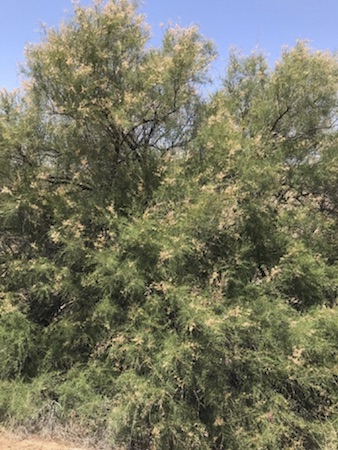Southwest Yard & Garden by Dr. Marisa Thompson Figure 1. Invasive saltcedar, also known as tamarisk, near Isleta Pueblo (photo credit M. Thompson
Figure 1. Invasive saltcedar, also known as tamarisk, near Isleta Pueblo (photo credit M. Thompson
I have a saltcedar I inherited when I moved into my rental home in Zuni, NM. I have cut it back to a stump as best I could without a chainsaw or any power tools, but it incessantly puts out shoots and tries to stage a comeback. What is the simplest way to permanently kill this invasive beast?
- Tammy P., Zuni, NM
Answer:
You are not alone in your saltcedar frustrations. I invited NMSU Extension Weed Specialist, Dr. Leslie Beck, to review your options:
“Saltcedar is a highly invasive and difficult-to-control noxious weed throughout the Southwestern states. Many of its growth characteristics contribute to its difficult management, most notably the primary root system, which can penetrate more than 30 feet deep in the soil, and aggressive lateral rhizomes that are responsible for many of the shoots that return after cutting. The plant crown (where the main body of the plant meets the root system) must be damaged beyond repair for effective control. The crown on a saltcedar can extend several feet below the soil surface, further contributing to its difficult control.
Practices that target and destroy the root system are the best way to manage saltcedar. Any methods that damage or remove the aboveground tissue without addressing the roots, such as cutting back the branches, will only result in regrowth and re-sprouting of underground suckers. An integrated pest management (IPM) strategy combining as many different control methods as possible to cause maximum damage to the plant over a period of several growing seasons is a must! Meanwhile, try to prevent new seed production as much as possible because seed can germinate within 24 hours of coming into contact with the soil.
Mechanical methods, such as hand excavators and large-scale mowers/grinders, can be an effective method of control; however, multiple applications over several growing seasons are required to exhaust the root system. Grubbing, which uses a tool mounted on a tractor’s hydraulic system to drive a blade into the soil, sever the root system, and bring the crown to the surface, can be highly effective and may not require as many repeated applications as traditional mowing and pruning.
Prescribed fire is often suggested for saltcedar control; however, it’s not effective in the long-term. Fire cannot penetrate several feet into the soil to damage the crown and root system, so the plant simply grows back. On the other hand, prescribed burning of any pruned or broken branches can prevent reestablishment and further spread of the plant from vegetative structures and can also help to remove dead or damaged plants after herbicide applications. Of course, extreme caution should be taken when utilizing prescribed fire as a management tool.
There are a few options for biological control of saltcedar; one of the oldest, and quite frankly the cutest, is goat grazing. Goats may be effective at suppressing re-sprouting shoots after other management methods have been used, but, like fire, they cannot graze under the soil to damage the crown/root system. In more recent years, the tamarisk beetle (Diorhabda spp.) has moved throughout the state of New Mexico to feed on saltcedar foliage. Research indicates that continual defoliation over a period of 4–5 years can lead to 50–60% suppression of the plant. However, like the goats, the beetles don’t feed on the root system. Thus, the plant continually re-foliates and continues to grow. Additionally, though beetle populations have naturally expanded throughout the state, permits are required for their intentional release. Permits in the state of New Mexico have been permanently suspended to protect the nesting sites of the endangered southwestern willow flycatcher. As a whole, biological control can help to suppress weed populations, though they will not outright control weed species without the incorporation of other management strategies (IPM).
Herbicides are the primary method of saltcedar control and can be applied in a number of ways. Applicators should always, always read and follow the directions on the label to ensure an effective and safe herbicide application. Cut and stump methods, where the herbicide is applied directly to the cambium tissue at the removal site, can be effective if applied within 15 minutes of the initial cut. Foliar and/or basal bark applications can be effective if the herbicide is combined (according to label instructions) with an oil or surfactant to help the herbicide penetrate the bark or the leaves. Repeated applications are often required to address regrowth of the saltcedar plant and its suckers. With any herbicide application, efforts should be taken to limit the application only to the target weed as much as possible. Visit https://nmsudesertblooms.blogspot.com/ for more information.
There really is no quick way to manage a saltcedar infestation effectively. As with any troublesome weed, the more management options that can be combined (IPM) for effective and longer-lasting damage to the weed can aid in the success of effective control. Even with effective IPM practices, successful management of saltcedar will take multiple seasons of implementation and monitoring to ensure control. Hang in there!”
Send gardening questions to Southwest Yard and Garden - Attn: Dr. Marisa Thompson at desertblooms@nmsu.edu , or at the NM Desert Blooms Facebook page (@NMDesertBlooms)
Please copy your County Extension Agent (http://aces.nmsu.edu/county/) and indicate your county of residence when you submit your question!
For more gardening information, visit the NMSU Extension Horticulture page at Desert Blooms (http://desertblooms.nmsu.edu/) and the NMSU Horticulture Publications page at http://aces.nmsu.edu/pubs/_h/ .
Marisa Y. Thompson, Ph.D., is the Extension Horticulture Specialist, in the Department of Extension Plant Sciences at the New Mexico State University Los Lunas Agricultural Science Center, office: 505- 865-7340, ext. 113.


